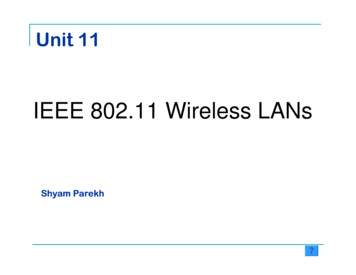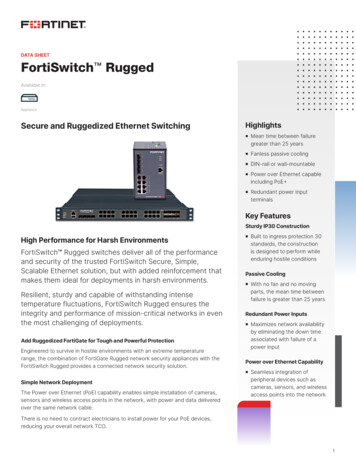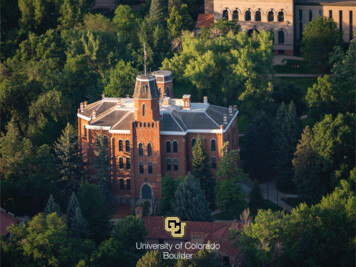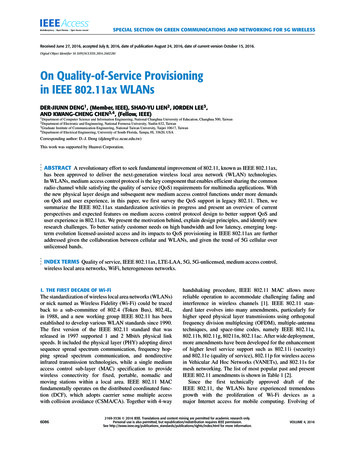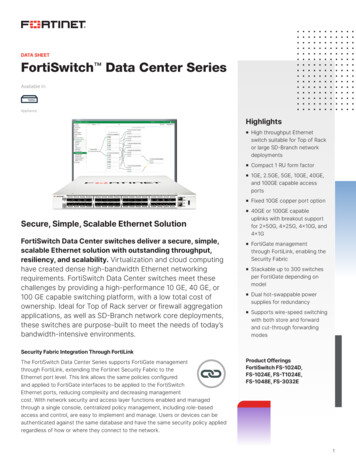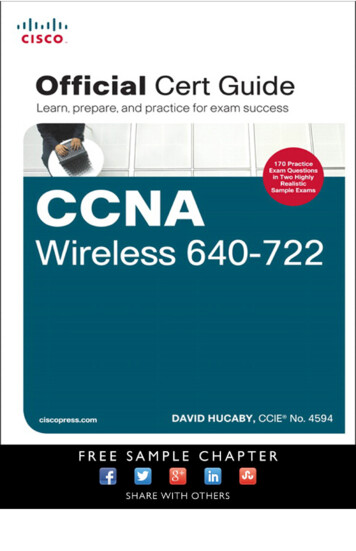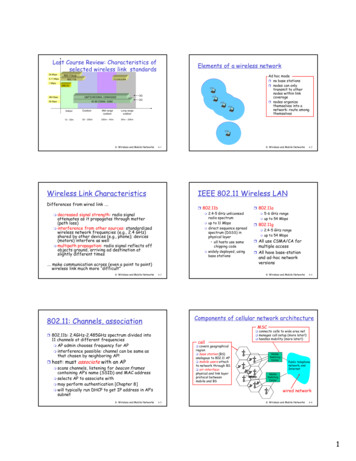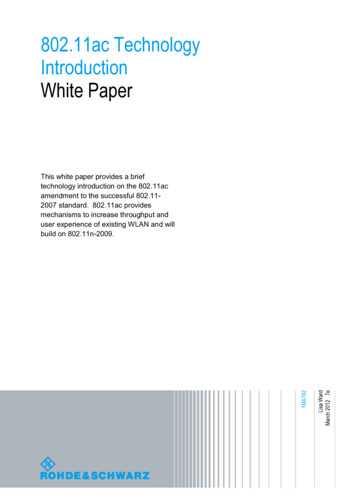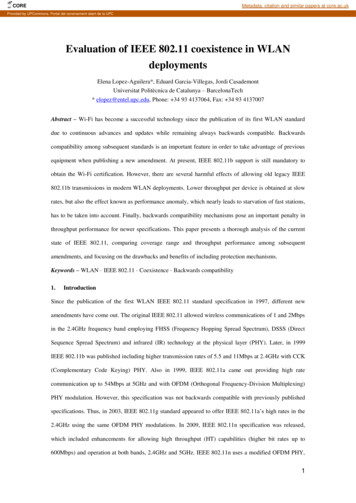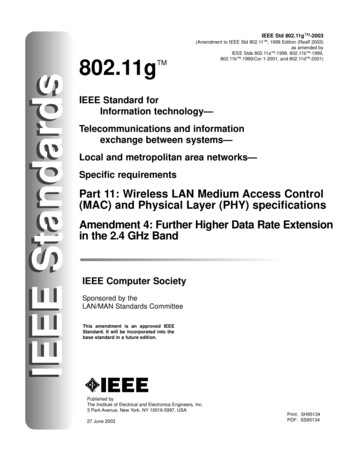
Transcription
IEEE StandardsIEEE Std 802.11g -2003802.11gTM(Amendment to IEEE Std 802.11 , 1999 Edition (Reaff 2003)as amended byIEEE Stds 802.11a -1999, 802.11b -1999,802.11b -1999/Cor 1-2001, and 802.11d -2001)IEEE Standard forInformation technology—Telecommunications and informationexchange between systems—Local and metropolitan area networks—Specific requirementsPart 11: Wireless LAN Medium Access Control(MAC) and Physical Layer (PHY) specificationsAmendment 4: Further Higher Data Rate Extensionin the 2.4 GHz BandIEEE Computer SocietySponsored by theLAN/MAN Standards CommitteeThis amendment is an approved IEEEStandard. It will be incorporated into thebase standard in a future edition.Published byThe Institute of Electrical and Electronics Engineers, Inc.3 Park Avenue, New York, NY 10016-5997, USA27 June 2003Print: SH95134PDF: SS95134
IEEE Std 802.11g -2003[Amendment to IEEE Std 802.11TM, 1999 Edition (Reaff 2003)as amended byIEEE Stds 802.11aTM-1999, 802.11bTM-1999,802.11bTM-1999/Cor 1-2001, and 802.11dTM-2001]IEEE Standard forInformation technology—Telecommunications and information exchangebetween systems—Local and metropolitan area networks—Specific requirementsPart 11: Wireless LAN Medium AccessControl (MAC) and Physical Layer (PHY)specificationsAmendment 4: Further Higher Data RateExtension in the 2.4 GHz BandSponsorLAN/MAN Standards Committeeof theIEEE Computer SocietyApproved 12 June 2003IEEE-SA Standards BoardAbstract: Changes and additions to IEEE Std 802.11, 1999 Edition, as amended by IEEE Stds802.11a-1999, 802.11b-1999, 802.11b-1999/Cor 1-2001, and 802.11d-2001, are provided to support the further higher data rate extension for operation in the 2.4 GHz band.Keywords: LAN, local area network, radio frequency, wirelessThe Institute of Electrical and Electronics Engineers, Inc.3 Park Avenue, New York, NY 10016-5997, USACopyright 2003 by the Institute of Electrical and Electronics Engineers, Inc.All rights reserved. Published 25 June 2003. Printed in the United States of America.IEEE and 802 are registered trademarks in the U.S. Patent & Trademark Office, owned by the Institute of Electrical andElectronics Engineers, Incorporated.Print:PDF:ISBN 0-7381-3700-6ISBN 0-7381-3701-4SH95134SS95134No part of this publication may be reproduced in any form, in an electronic retrieval system or otherwise, without the priorwritten permission of the publisher.
IEEE Standards documents are developed within the IEEE Societies and the Standards Coordinating Committees of the IEEE Standards Association (IEEE-SA) Standards Board. The IEEE develops its standards through a consensus development process, approvedby the American National Standards Institute, which brings together volunteers representing varied viewpoints and interests to achievethe final product. Volunteers are not necessarily members of the Institute and serve without compensation. While the IEEE administersthe process and establishes rules to promote fairness in the consensus development process, the IEEE does not independently evaluate,test, or verify the accuracy of any of the information contained in its standards.Use of an IEEE Standard is wholly voluntary. The IEEE disclaims liability for any personal injury, property or other damage, of anynature whatsoever, whether special, indirect, consequential, or compensatory, directly or indirectly resulting from the publication, useof, or reliance upon this, or any other IEEE Standard document.The IEEE does not warrant or represent the accuracy or content of the material contained herein, and expressly disclaims any express orimplied warranty, including any implied warranty of merchantability or fitness for a specific purpose, or that the use of the materialcontained herein is free from patent infringement. IEEE Standards documents are supplied “AS IS.”The existence of an IEEE Standard does not imply that there are no other ways to produce, test, measure, purchase, market, or provideother goods and services related to the scope of the IEEE Standard. Furthermore, the viewpoint expressed at the time a standard isapproved and issued is subject to change brought about through developments in the state of the art and comments received from usersof the standard. Every IEEE Standard is subjected to review at least every five years for revision or reaffirmation. When a document ismore than five years old and has not been reaffirmed, it is reasonable to conclude that its contents, although still of some value, do notwholly reflect the present state of the art. Users are cautioned to check to determine that they have the latest edition of any IEEE Standard.In publishing and making this document available, the IEEE is not suggesting or rendering professional or other services for, or onbehalf of, any person or entity. Nor is the IEEE undertaking to perform any duty owed by any other person or entity to another. Any person utilizing this, and any other IEEE Standards document, should rely upon the advice of a competent professional in determining theexercise of reasonable care in any given circumstances.Interpretations: Occasionally questions may arise regarding the meaning of portions of standards as they relate to specific applications.When the need for interpretations is brought to the attention of IEEE, the Institute will initiate action to prepare appropriate responses.Since IEEE Standards represent a consensus of concerned interests, it is important to ensure that any interpretation has also received theconcurrence of a balance of interests. For this reason, IEEE and the members of its societies and Standards Coordinating Committeesare not able to provide an instant response to interpretation requests except in those cases where the matter has previously received formal consideration.Comments for revision of IEEE Standards are welcome from any interested party, regardless of membership affiliation with IEEE. Suggestions for changes in documents should be in the form of a proposed change of text, together with appropriate supporting comments.Comments on standards and requests for interpretations should be addressed to:Secretary, IEEE-SA Standards Board445 Hoes LaneP.O. Box 1331Piscataway, NJ 08855-1331USANote: Attention is called to the possibility that implementation of this standard may require use of subject matter coveredby patent rights. By publication of this standard, no position is taken with respect to the existence or validity of any patentrights in connection therewith. The IEEE shall not be responsible for identifying patents for which a license may berequired by an IEEE standard or for conducting inquiries into the legal validity or scope of those patents that are broughtto its attention. A patent holder has filed a statement of assurance that it will grant licenses under these rights without compensation or under reasonable rates and nondiscriminatory, reasonable terms and conditions to all applicants desiring toobtain such licenses. The IEEE makes no representation as to the reasonableness of rates and/or terms and conditions ofthe license agreements offered by patent holders. Further information may be obtained from the IEEE StandardsDepartment.Authorization to photocopy portions of any individual standard for internal or personal use is granted by the Institute of Electrical andElectronics Engineers, Inc., provided that the appropriate fee is paid to Copyright Clearance Center. To arrange for payment of licensingfee, please contact Copyright Clearance Center, Customer Service, 222 Rosewood Drive, Danvers, MA 01923 USA; 1 978 750 8400.Permission to photocopy portions of any individual standard for educational classroom use can also be obtained through the CopyrightClearance Center.
IntroductionThis introduction is not part of IEEE Std 802.11g-2003 (Amendment to IEEE Std 802.11, 1999 Edition,as amended by IEEE Stds 802.11a-1999, 802.11b-1999, 802.11b-1999/Cor 1-2001, and 802.11d-2001),IEEE Standard for Information Technology—Telecommunications and Information Exchange betweenSystems—Local and Metropolitan Area Networks—Specific Requirements—Part 11: Wireless LAN Medium Access Control (MAC) and Physical Layer (PHY) specifications—Amendment 4: Further HigherData Rate Extension in the 2.4 GHz Band.802.2 LOGICAL LINK.802.1 MANAGEMENT802 OVERVIEW & ARCHITECTURE*802.10 SECURITYThis amendment is part of a family of standards for local and metropolitan area networks. The relationshipbetween the standard and other members of the family is shown below. (The numbers in the figure refer toIEEE standard designations.1)DATALINKLAYER802.1 BRIDGING802.3 MEDIUMACCESS802.5 MEDIUMACCESS802.11 MEDIUMACCESS802.15 MEDIUMACCESS802.16 AL802.15PHYSICAL802.16PHYSICALPHYSICALLAYER* Formerly IEEE Std 802.1A .This family of standards deals with the Physical and Data Link layers as defined by the InternationalOrganization for Standardization (ISO) Open Systems Interconnection (OSI) Basic Reference Model (ISO/IEC 7498-1: 1994). The access standards define five types of medium access technologies and associatedphysical media, each appropriate for particular applications or system objectives. Some access standardshave been withdrawn and other types are under investigation.The standards defining the technologies noted above are as follows: IEEE Std 802:2Overview and Architecture. This standard provides an overview to the family ofIEEE 802 Standards. IEEE Std 802.1B and 802.1k [ISO/IEC 15802-2]LAN/MAN Management. Defines an OSI management-compatible architectureand services and protocol elements for use in a LAN/MAN environment forperforming remote management. IEEE Std 802.1D Media Access Control (MAC) Bridges. Specifies an architecture and protocolfor the interconnection of IEEE 802 LANs below the MAC service boundary.1The IEEE standard designations referred to in the above figure and list are trademarks owned by the Institute of Electrical andElectronics Engineers, Incorporated.2The IEEE 802 Overview and Architecture Specification, originally known as IEEE Std 802.1A, has been renumbered as IEEE Std 802.This has been done to accommodate recognition of the base standard in a family of standards. References to IEEE Std 802.1A should beconsidered as references to IEEE Std 802.Copyright 2003 IEEE. All rights reserved.iii
IEEE Std 802.1E [ISO/IEC 15802-4]System Load Protocol. Specifies a set of services and protocol for those aspectsthose aspects of management concerned with the loading of systems on IEEE802 LANs. IEEE Std 802.1F Common Definitions and Procedures for IEEE 802 Management Information. IEEE Std 802.1G [ISO/IEC 15802-5]:Remote Media Access Control (MAC) Bridging. Specifies extensions for theinterconnection, using non-LAN systems communication technologies, ofgeographically separated IEEE 802 LANs below the level of the logical linkcontrol protocol. IEEE Std 802.1H [ISO/IEC TR 11802-5]Recommended Practice for Media Access Control (MAC) Bridging of EthernetV2.0 in IEEE 802 Local Area Networks. IEEE Std 802.1Q Virtual Bridged Local Area Networks. Defines an architecture for VirtualBridged LANs, the services provided in Virtual Bridged LANs, and the protocols and algorithms involved in the provision of those services. IEEE Std 802.2[ISO/IEC 8802-2]Logical Link Control. IEEE Std 802.3CSMA/CD Access Method and Physical Layer Specifications. IEEE Std 802.5[ISO/IEC 8802-5]Token Ring Access Method and Physical Layer Specifications. IEEE Std 802.10Standard for Interoperable LAN Security (SILS). Currently approved: SecureData Exchange (SDE). IEEE Std 802.11[ISO/IEC 8802-11]Wireless LAN Medium Access Control (MAC) Sublayer and Physical LayerSpecifications. IEEE Std 802.15Wireless Medium Access Control (MAC) and Physical Layer (PHY)Specifications for: Wireless Personal Area Networks. IEEE Std 802.16Air Interface for Fixed Broadband Wireless Access Systems.The reader of this standard is urged to become familiar with the complete family of standards.ivCopyright 2003 IEEE. All rights reserved.
ParticipantsWhen the IEEE 802.11 Working Group approved this standard, it had the following membership:Stuart J. Kerry, ChairAl Petrick and Harry Worstell, Vice-ChairsTim Godfrey, SecretaryBrian Mathews, Publicity Standing CommitteeTeik-Kheong Tan, Wireless Next-Generation Standing CommitteeJohn Fakatselis, Chair Task Group eDuncan Kitchin, Vice-Chair Task Group eDavid Bagby, Chair Task Group fMika Kasslin, Chair Task Group hDavid Halasz, Chair Task Group iWhen the IEEE 802.11 Working Group approved this standard, the Task Group G had the followingmembership:Matthew B. Shoemake, ChairJohn Terry, Vice-ChairCarl F. Andren, Technical EditorKevin Smart, SecretaryTomoko AdachiAreg AlimianRichard AllenKeith AmannMerwyn AndradeButch AntonMitch AramakiTakashi AramakiLarry ArnettGeert A. AwaterFloyd BackesDavid BagbyJay BainDennis J. BakerBala BalachanderRaja BanerjeaBoyd BangerterSimon BarberGil Bar-NoyJohn BarrKevin M. BarryAnuj BatraTomer BentzionMathilde BenvenisteSimon BlackJan BoerJim BrennanRonald BrockmannAlistair G. ButtarNancy Cam-WingetBill CarneyPat CarsonClint ChaplinHung-Kun ChenYi-Ming ChenGreg ChessonAlan ChickinskyAik ChindapolLeigh M. ChinitzCopyright 2003 IEEE. All rights reserved.Bong-Rak ChoiSunghyun ChoiKen ClementsJohn T. CoffeyTerry ColePaul CongdonCraig ConklingTodor CooklevThomas P. CostasWm. Caldwell CrosswyPeter DahlBarry DavisRolf De VegtJavier del PradoMichael DerbyGeorg DickmannWim DiepstratenRoger DurandEryk DutkiewiczMary DuValDonald E. Eastlake IIIDennis EatonPeter EcclesineJon EdneyChristoph EuscherJohn FakatselisLars FalkAugustin J. FarrugiaWeishi FengNorm FinnMatthew James FischerKenji FujisawaMarcus GahlerJames GardnerAtul GargAl GarrettVafa GhaziTim GodfreyWataru GohdaPeter GoidasAlex GorokhovRik GraulusEvan GreenLarry GreenPatrick GreenKerry GreerDaqing GuSrikanth GummadiFred HaischDavid HalaszSteve D. HalfordMark HamiltonChristopher J. HansenYasuo HaradaAmer A. HassanKevin HayesVictor HayesChris HeegardRobert HeileGarth HillmanChristopher HinszJun HiranoMikael HjelmJin-Meng HoMaarten HoebenMichael HoghooghiAllen HollisterSrinath HosurRussell HousleyFrank P Howley, Jr.Dave HudakJohn HughesDavid HunterDavid HythaHiroshi IdeDaichi ImamuraYasuhiko InoueKatsumi IshiiEric Jacobsenv
Marc JalfonPeter JohanssonDavid JohnstonV. K. JonesBobby JoseDaryl KaiserSrinivas KandalaJeyhan KaraoguzKevin KarczMika KasslinPatrick KellyStuart J. KerryAndrew K. KhieuJamshid Khun-JushRyoji KidoDukhyun KimEdward KimJe Woo KimJoonsuk KimZiv KimhiDuncan KitchinGünter KleindlCees KlikDavid KlineJohn M. KowalskiBruce P. KraemerThomas KuehnelDenis KuwaharaJoe KwakPaul A. LambertDavid S. LandetaJim LansfordColin LanzlKim LaraquiJon LaRosaDavid J. Leach, Jr.Dongjun LeeRichard van LeeuwenMartin LefkowitzUriel LembergerOnno LetancheMike LewisSheung LiJie LiangIsaac Lim Wei LihHuashih A. LinShawn LiuTitus LoPeter LocRalph Lombardo, Jr.Luke LudemanYeong-Chang MaaAkira MaekiDouglas MakishimaMahalingam ManiRoger MarksBrian MathewsJo-Ellen F MathewsMark MathewsThomas MauferConrad MaxwellJustin McCannKelly McClellanGary McCoyBill McFarlandGary McGarrBill McIntoshJorge MedinaMehul MehtaPratik MehtaviRobert C. MeierGraham MelvilleKlaus MeyerRobert MillerPartho MishraYasuhiko MizoguchiLeo MontebanMichael MontemurroTim MooreMike MoretonRoy MorrisRobert MoskowitzOliver MuelhensPeter MurphyPeter MurrayAndrew MylesRavi NarasimhanKevin NegusDavid B. NelsonDan NemitsChiu NgoQiang NiGunnar NitscheErwin R. NobleHiroshi NomuraTzvetan D. NovkovIvan OakesBob O’HaraYoshihiro OhtaniKazuhiro OkanoueLior OphirRichard H. PaineMike PaljugVijay M. PatelLizy PaulSebastien PerrotAl PetrickJames PortaroAl PotterMike PressRon ProvencioHenry PtasinskiRaad RaadAli RaissiniaMurali RamadossNoman RangwalaIvan ReedeStanley A. ReibleDanny RettigEdward ReussBill RhyneJim RichardsDavid RichkasMaximilian RiegelCarlos A. RiosBenno RitterKent G. RollinsStefan RommerJon RosdahlPejman RoshanReinhard RuckriemAli SadriKenichi SakusabeAntonio Salloum SalazarJohn H. SanthoffAnil K. SanwalkaSid SchrumErik SchylanderMichael SealsJoe SensendorfYangmin ShenMatthew ShermanWilliam ShvodianDavid SkellernDonald I. SloanAndrew SmithDave SmithYoram SolomonWei-Jei SongAmjad SoomroGary SpiessDorothy V. StanleyAdrian StephensCarl R. StevensonPaul F StruhsakerMichael SuMasahiro TakagiMinoru TakemotoPek-Yew TanTeik-Kheong TanTakuma TanimotoRoger TeagueCarl TemmeYossi TexermanJerry A. ThrasherJames D. TomcikWalt TrzaskusAllen TsaiChih C. TsienTom TsoulogiannisToru UedaNaoki UranoNiels Van ErvenWim J. van HoutumRichard van NeePatrick VandenameeleDmitri VarsanofievJagannatha L. VenkateshaMadan VenugopalNanci VogtliDennis VolpanoToan X. VuTim WakeleyJesse R. WalkerBrad WallaceThierry WalrantChristopher WareFujio WatanabeMark WebsterMenzo WentinkRobert WhelanMichael WilhoyteRichard G.C. WilliamsSteven D. WilliamsTimothy G. WongHarry WorstellCharles R. WrightMicheal WrightLiwen WuYang XiaoShugong XuJung YeeKit YongAlbert YoungHeejung YuPatrick YuGlen ZornArnoud ZwemmerJim ZyrenCopyright 2003 IEEE. All rights reserved.
The following members of the balloting committee voted on this standard. Balloters may have voted forapproval, disapproval, or abstention.Butch AntonEladio ArveloDavid BagbyJohn BarnettJohn BarrJan BoerMitchell BuchmanKimara ChinKeith ChowTerry ColeMichael ColettaTodor CooklevTodd CooperGuru Dutt DhingraThomas DineenSourav DuttaPeter EcclesineDarrell FletcherKeng FongAvraham FreedmanMichele GammelAndrew GermanoJames GilbTim GodfreyRajugopal GubbiQiang GuoVictor HayesGerald HellerSrinivas KandalaStuart J. KerryThomas A. KimYongsuk KimJohn M. KowalskiPi-Cheng LawAmir LeshemDaniel LevesqueSheung LiJeb LintonKyle MausMichael McInnisGeorge MiaoApurva ModyLeo MontebanMike MoretonAndrew MylesCharles NgethePaul NikolichErwin R. NobleEllis NolleyTimothy O’FarrellBob O’HaraSatoshi OyamaSebastien PerrotIan PerrymanSubbu PonnuswamyHugo PuesVikram PunjCharles RiceMaximilian RiegelJon RosdahlDouglas SandersonMichael SealsStephen ShellhammerMatthew ShermanNeil ShippGil ShultzKevin SmartAmjad SoomroMinoru TakemotoJerry A. ThrasherDmitri VarsanofievHung-yu WeiEdward WoodrowHarry WorstellJung YeeOren YuenArnoud ZwemmerWhen the IEEE-SA Standards Board approved this standard on 12 June 2003, it had the followingmembership:Don Wright, ChairHoward M. Frazier, Vice ChairJudith Gorman, SecretaryH. Stephen BergerJoe BruderBob DavisRichard DeBlasioJulian Forster*Toshio FukudaArnold M. GreenspanRaymond HapemanDonald M. HeirmanLaura HitchcockRichard H. HulettAnant JainLowell G. JohnsonJoseph L. Koepfinger*Tom McGeanSteve MillsDaleep C. MohlaWilliam J. MoylanPaul NikolichGary RobinsonMalcolm V. ThadenGeoffrey O. ThompsonDoug ToppingHoward L. Wolfman*Member EmeritusAlso included are the following nonvoting IEEE-SA Standards Board liaisons:Alan Cookson, NIST RepresentativeSatish K. Aggarwal, NRC RepresentativeMichelle TurnerIEEE Standards Project EditorCopyright 2003 IEEE. All rights reserved.vii
CONTENTS3.Definitions . 24.Abbreviations and acronyms . 27.Frame formats . 27.2 Format of individual frame types. 27.2.1 Control frames . 27.2.1.2 CTS frame format . 27.2.3 Management frames. 27.2.3.1 Beacon frame format . 37.2.3.4 Association Request frame format. 37.2.3.5 Association Response frame format . 47.2.3.6 Reassociation Request frame format . 47.2.3.7 Reassociation Response frame format . 47.2.3.8 Probe Request frame format . 57.2.3.9 Probe Response frame format. 57.3 Management frame body components. 67.3.1 Fixed fields . 67.3.1.4 Capability Information field . 67.3.1.9 Status code field. 87.3.2 Information elements . 87.3.2.2 Supported Rates element . 87.3.2.13 ERP Information element . 97.3.2.14 Extended Supported Rates element . 109.MAC sublayer functional description. 119.2 DCF. 119.2.11 NAV distribution . 119.2.12 Determination of PLME aCWmin characteristics . 119.6 Multirate support. 129.7 Frame exchange sequences. 139.10 Protection mechanism. 1310.Layer management. 1410.4 PLME SAP interface . 1410.4.4 PLME-DSSSTESTMODE. 1410.4.4.2 PLME-DSSSTESTMODE.request . 1418.High Rate direct sequence spread spectrum (HR/DSSS) PHY specification . 1418.2 High Rate PLCP sublayer . 1418.2.2 PPDU format. 1418.2.2.2 Short PPDU format (optional) . 14viiiCopyright 2003 IEEE. All rights reserved.
19.Extended Rate PHY specification. 1519.1 Overview. 1519.1.1 Introduction. 1519.1.2 Operational modes . 1519.1.3 Scope. 1619.1.4 Extended Rate PHY functions . 1619.2 PHY specific service parameter list. 1719.3 Extended Rate PLCP sublayer. 1819.3.1 Introduction. 1819.3.2 PPDU format. 1819.3.2.1 Long preamble PPDU format . 1919.3.2.1.1 ERP PLCP length field calculation. 1919.3.2.1.2 ERP-PBCC PLCP length (LENGTH) field calculation . 1919.3.2.2 Short preamble PPDU format . 2019.3.2.3 ERP-OFDM PPDU format . 2019.3.2.4 DSSS-OFDM long preamble PPDU format . 2119.3.2.4.1 DSSS-OFDM PLCP length field calculation. 2119.3.2.5 Short DSSS-OFDM PLCP PPDU format. 2219.3.3 PLCP data modulation and rate change. 2219.3.3.1 Long and short preamble formats . 2219.3.3.2 ERP-PBCC 22 Mbit/s and 33 Mbit/s formats. 2319.3.3.3 ERP-OFDM format. 2519.3.3.4 Long & short DSSS-OFDM PLCP format . 2519.3.3.4.1 Overview of the DSSS-OFDM PLCP PSDU encoding process. 2619.3.3.4.2 Long sync training sequence definition . 2619.3.3.4.3 OFDM signal field definition . 2619.3.3.4.4 Data symbol definition. 2619.3.3.4.5 DSSS-OFDM signal extension . 2719.3.4 PLCP transmit procedure. 2719.3.5 CCA . 2719.3.6 PLCP receive procedure . 2719.4 ERP PMD operating specifications (general) . 2819.4.1 Regulatory requirements. 2819.4.2 Operating channel frequencies. 2819.4.3 Transmit and receive in-band and out-of-band spurious emissions . 2819.4.4 Slot time. 2819.4.5 SIFS value. 2819.4.6 CCA performance . 2819.4.7 PMD transmit specifications. 2919.4.7.1 Transmit power levels. 2919.4.7.2 Transmit center frequency tolerance. 2919.4.7.3 Symbol clock frequency tolerance. 2919.5 ERP operation specifications . 2919.5.1 Receiver minimum input level sensitivity . 2919.5.2 Adjacent channel rejection. 3019.5.3 Receive maximum input level capability. 3019.5.4 Transmit spectral mask . 3019.6 ERP-PBCC operation specifications . 3019.6.1 Receiver minimum input level sensitivity . 3019.6.2 Receiver adjacent channel rejection . 30Copyright 2003 IEEE. All rights reserved.ix
19.7 DSSS-OFDM operation specifications. 3119.7.1 Overview.
LAN/MAN Standards Committee of the IEEE Computer Society Approved 12 June 2003 IEEE-SA Standards Board Abstract: Changes and additions to IEEE Std 802.11, 1999 Edition, as amended by IEEE Stds 802.11a-1999, 802.11b-1999, 802.11

